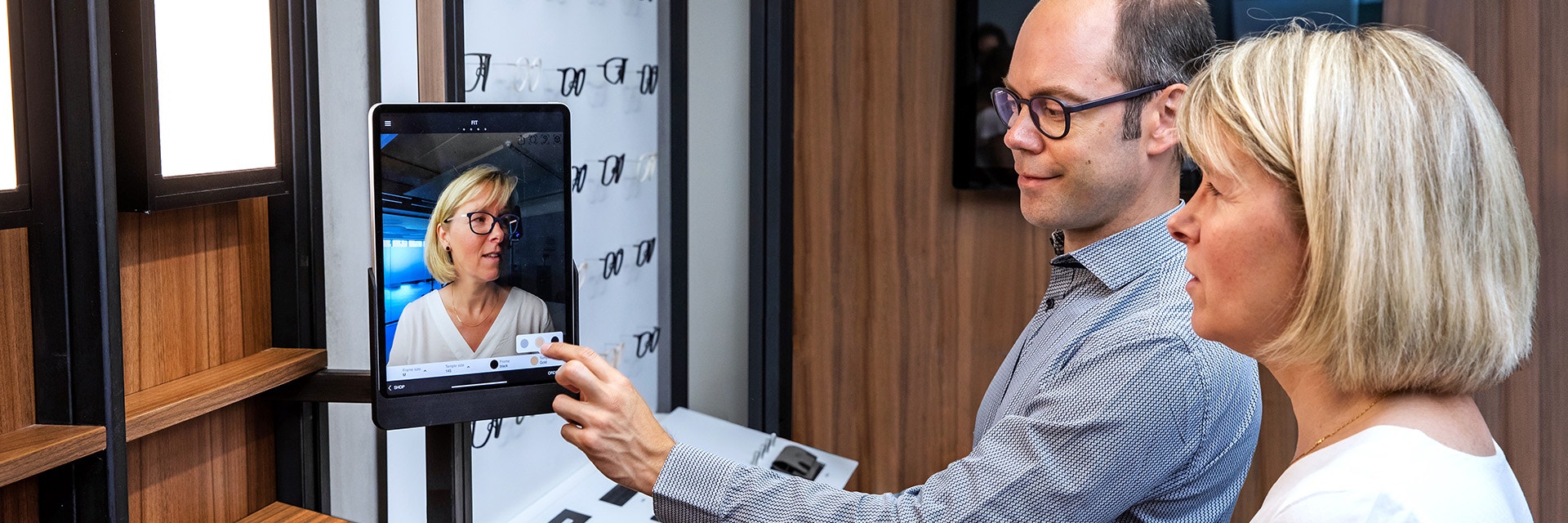EXPERT INSIGHT
Digitalization Has Enriched Eyewear’s Customer Journey — Now, It’s Paving The Way for An Exciting Tomorrow.

Thanks to a new wave of digital tools, customization in eyewear is accessible to a wider audience than ever. Here’s why retailers should trust in the digitalization revolution — and why their people have never been more important.
Retail is ruled by the bottom line. Every action, every decision, can be diluted down to a simple equation: cost vs. benefit. In essence, are the results worth the investment? Personalization is no exception. From tools to training to the (lack of) economies of scale, allowing customers to customize the products they buy comes with a price. Whether that price is worth paying often varies across industries.
But eyewear — and the luxury end of the spectrum in particular — is special. Few other industries can identify the cost of not doing something quite as clearly as this one. A recent empirical study of 4,500 adults in the UK and the US has shown that retailers in these countries who choose not to offer a personalized experience contribute to $26 billion dollars of lost revenue every year1.
The reason is simple. Retail, in general, can see the growing interest in customization. But statistics show that interest has become necessity when customers visit eyewear retailers. The study confirms that in this market, fit matters most — yet, 1 in 4 adults in the UK and US leave stores disappointed and empty-handed2, their needs unmet. Investing in functional customization is now essential — and we have proof that we have the digital tools to meet the needs of both retailers and customers.


It’s called the Eyewear Fitting Suite
With this in-store platform, retailers can scan the customer’s face using a handheld device, create an anatomically exact 3D model, and then guide them through a selection process. Together, they can adjust shapes, colors, sizes, and more, ultimately creating a unique frame (and a unique customer journey) that suits each buyer perfectly.
Acuitis, a leading French retail group, has rolled out the suite in more than 100 stores since December 2022, with opticians and customers showing plenty of interest in the technology. Within the first nine months, use of the scanner has been intensive — and it’s translated into sales. The conversion rate is high, resulting in thousands of happy customers. They appreciate the co-creation it offers, and the in-store opticians can take advantage of this new tool to provide better customer service than ever before.
The role of digital manufacturing technologies
Beyond the scanner itself, it is advances in 3D printing and other digital manufacturing technologies that have made it possible for retailers to meet the demand for customization. By utilizing core assets like design freedom, they can serve their users’ needs quickly, affordably, and in batches of one.
For eyewear, this customization comes in many forms, from visual, such as unique designs and an array of colors, to functional, such as size and part placement. In both cases, the goal is the same: to provide a perfect fit.
The potential of these tools is undeniable. But that doesn’t mean pursuing a digital customer journey comes without challenges.
So, what are they?
Firstly, visibility. How can retailers spread the word, entice potential customers to visit their store, and make it a central part of the in-store experience? Secondly, scale. How can they utilize these technological advancements across an entire chain, ensuring consistency of service and results in every location?
The answers to both revolve around a core component of eyewear’s customer journey — one that can never be forgotten. People. The opticians, the experts, the friendly faces at the front door — and, of course, the happy customers-turned-ambassadors who advertise through word of mouth. Technology, as good as it is, is nothing without them. If retailers want their customers to believe in their new digital journey, their own people must believe in it first.
To make that happen, it’s important that retailers invest not just financially, buying into digital manufacturing or platforms like the Eyewear Fitting Suite, but time. They must ensure that the opticians not only know how it works but understand its role in the journey. It is not a replacement but a tool to help them provide a better service to their customers and a truly custom solution — one they’ll tell their friends about.
Do that, and we might just see a future where every customer leaves the store with eyewear that fits them perfectly.
1,2: Thaw, G., 2019. Delivering a Fitted Experience in eyewear, A Research Study Into the Importance of Fit on Buyer Experience, s.l.: fitsyou.fuel3d.com.
Share on:

Meet the author
Alireza Pandarian
You might also like
Never miss a story like this. Get curated content delivered straight to your inbox.
